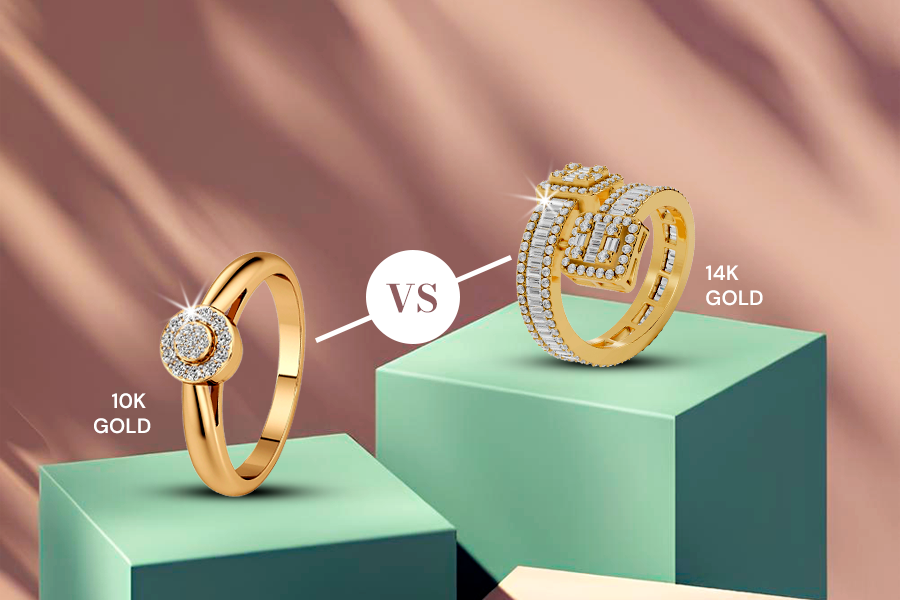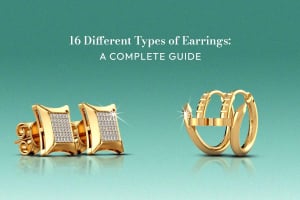
10K Vs 14K Gold
Do you like gold jewelry and looking to buy one? Prior to making a purchase, one should be aware of types of gold jewelry and karatage. Gold jewelry is available in different karatages, and 10K gold and 14K gold are two of the most common types. Both of them possess a unique set of gold content, durability, and price, and hence it is crucial to learn about the differences between them prior to purchasing. Whether you're planning to invest in an affordable everyday piece or expensive statement jewelry, knowing how the two forms of karat compare with regard to composition, hardness, cost, and usability for various jewelry designs will help you make an informed choice. This blog will get your 10k gold vs 14k gold dilemma sorted out for you, tell you what is best for you and why. So, let's get to the key differences and move towards a timeless buy!
Gold karatage
Karatage, abbreviated as "K" is the gold purity in jewelry. 24K gold is too soft for daily wear, therefore gold is mixed with other metals, such as copper, silver, or zinc, to increase its strength. 10K gold has 41.7% gold and 58.3% alloy metals. 14K gold has 58.3% gold and 41.7% alloy metals. The greater the karatage, the greater the gold content but also the more expensive and soft the jewelry.
The main differences between 10k and 14k gold
| Gold Content | 10K gold contains less gold than 14K gold and is less expensive. |
| Durability | 10K gold is harder and less prone to scratches because of its greater content of alloys. |
| Color | 14K gold is richer and warmer in color because it contains a higher percentage of gold. |
| Price | 14K gold is more expensive than 10K gold |
| Skin Friendly | 14K gold is less likely to irritate the skin than 10K gold, which has higher nickel content. |
Advantages and Disadvantages of 10K Gold
Cheap
It is the cheapest product offered in the gold market. It has less gold content, hence it is priced at a lesser rate, making it affordable for all customers.
Strength and Resistance
Being a higher percentage of alloy metals, 10K gold is stronger and more durable than higher karat gold. It is more resistant to scratches and dents and most suitable for everyday use in jewelry.
Daily Use
The strength of 10K gold is appropriate for daily jewelry such as rings, bracelets, and watches. It can endure wear and tear efficiently, maintaining its form even under extended exposure to frequent use.
Less Gold Content
As 10K gold contains less gold than 14K gold; its color is not as rich and is lighter. It is also pale, which might not be ideal for individuals who prefer a more traditional gold color.
More Alloy content
The higher percentage of alloy metals in 10K gold may cause skin irritation to individuals who are allergic to certain metals, such as nickel. It may cause discomfort or allergic reactions in certain wearers in the long run.
Lesser luxurious
Compared to 14K gold, 10K gold is generally less prestigious and luxurious. It is not typically used on heirloom pieces or engagement rings because it lacks the status and appearance that higher-karat gold offers.
Benefits and Drawbacks of 14k gold
Greater Gold Content
14K gold contains 58.3% gold content, which gives it a richer, deeper yellow appearance. The greater gold content gives the piece an aura of elegance and luxury, making it a pleasing aesthetic for high-end jewelry.
Greater Value
As 14K gold has a higher percentage of gold, its worth appreciates with the passage of time. This not only renders it a beautiful choice but a more precious one for those who are looking for an investment item in their collection of jewelry.
Less allergic
Due to the lower alloy metal content, 14K gold is less likely to cause an allergic reaction. This renders it more suitable for people with sensitive skin, as irritation or discomfort due to long-term wear is minimized.
Luxury Appeal
It is often used for occasion items of jewelry, including wedding bands and engagement rings. Its blend of strength and gold weight provides a high-end but functional allure to consumers who need a piece that embodies luxury.
More Costly
Due to the higher gold content, 14K gold is more expensive than 10K gold. The higher cost may not make it the most cost-effective choice, especially for consumers on a tight budget.
Softer
It is softer than 10K gold since it contains more gold. Due to that, it would be more susceptible to scratches and dings and might need special care and attention to maintain its look.
High maintenance
Unlike low-maintenance and durable 10K gold, 14K gold must be cleaned and kept in good condition on a regular basis to preserve its shine and prevent tarnishing. It may need to be polished and checked for scratches in the long term
10k gold vs 14k: Appropriateness & preference
10k gold is best suited for budget-conscious consumers, it is ideal for consumers looking for cheap gold jewelry. It is durable and strong but priced at a rate that makes it accessible to most consumers, including budget-conscious ones. The durability and strength of 10K gold make it ideal for jewelry that is worn on a daily basis, such as rings or bracelets. It can withstand the day-to-day wear and tear without deforming. It is widely used in items such as watches or other practical, daily jewelry. Its durability andvb cheapness make it ideal for industrial and mass- -production pieces.
14k gold is suitable for special occasions, and it is the standard choice for engagement rings, wedding bands, and other special occasion jewelry pieces. Its higher gold content gives it a more classic and elegant appearance, perfect for important life events. It is a better option for people with sensitive skin because it contains less alloy metals. This reduces the possibility of allergic reactions, and therefore it is a more comfortable choice for long wear.It is more valuable for resale because it has a greater proportion of gold. Over time, it will always retain value and sometimes even appreciate, which makes it a stronger investment than 10K gold.
Frequently Asked Questions
Gold Jewelry Trends & Styles
Gold jewelry's fashion scene is always changing but 14K gold and 10K gold is the timeless option. White gold, yellow gold, and rose gold are the popular options, along with minimalist jewelry, stacking rings, and vintage pieces. Layered necklaces and thick, bulky gold hoops are also current and thus both 10K and 14K gold are wonderful options depending on your fashion preference and budget.
Both 14K and 10K gold are beneficial in their own ways. It depends on your lifestyle, budget, and preference whether you go for one over the other. If you want durability or a stronger gold shade, either works well for different jewelry pieces. You'll enjoy the convenience of 10K gold or the elegance of 14K gold, whichever you prefer.
In order to stay current on the latest trends, styles, and expert advice on gold jewelry, visit the blog section of netcarat.com. Stay in the know in order to make an informed choice for your next jewelry buy!






